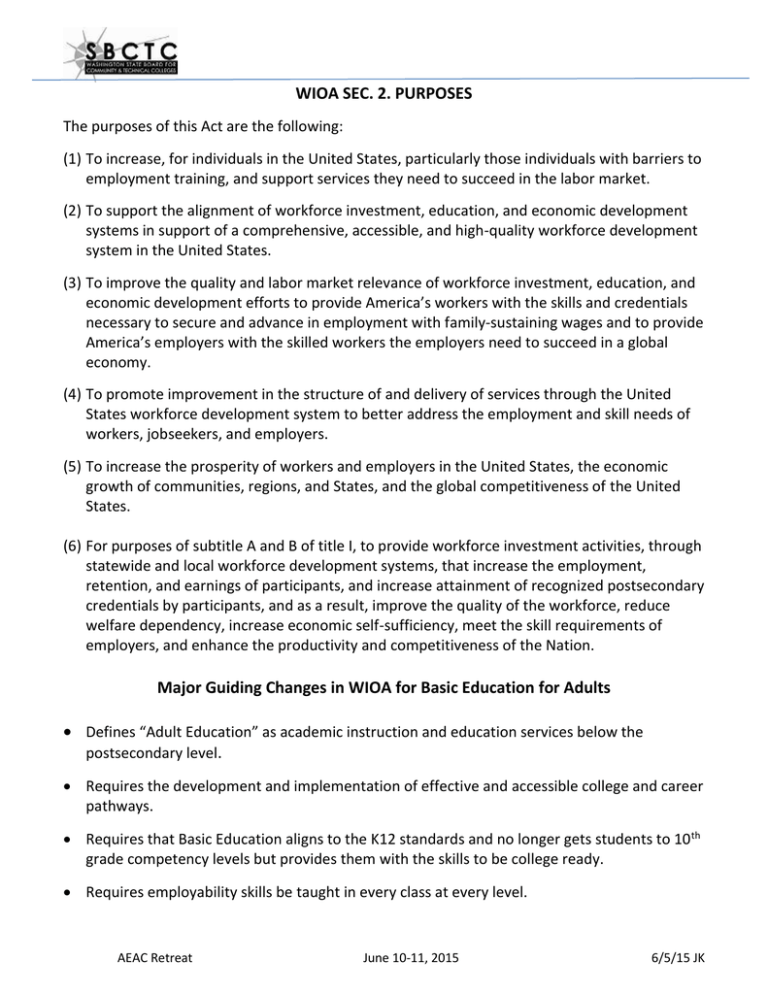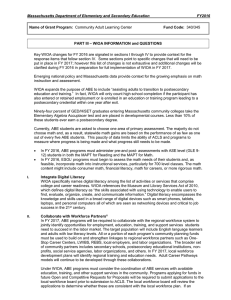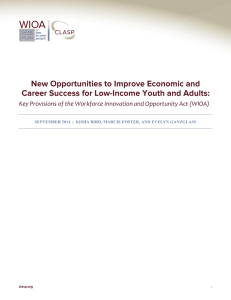WIOA SEC. 2. PURPOSES
advertisement

WIOA SEC. 2. PURPOSES The purposes of this Act are the following: (1) To increase, for individuals in the United States, particularly those individuals with barriers to employment training, and support services they need to succeed in the labor market. (2) To support the alignment of workforce investment, education, and economic development systems in support of a comprehensive, accessible, and high-quality workforce development system in the United States. (3) To improve the quality and labor market relevance of workforce investment, education, and economic development efforts to provide America’s workers with the skills and credentials necessary to secure and advance in employment with family-sustaining wages and to provide America’s employers with the skilled workers the employers need to succeed in a global economy. (4) To promote improvement in the structure of and delivery of services through the United States workforce development system to better address the employment and skill needs of workers, jobseekers, and employers. (5) To increase the prosperity of workers and employers in the United States, the economic growth of communities, regions, and States, and the global competitiveness of the United States. (6) For purposes of subtitle A and B of title I, to provide workforce investment activities, through statewide and local workforce development systems, that increase the employment, retention, and earnings of participants, and increase attainment of recognized postsecondary credentials by participants, and as a result, improve the quality of the workforce, reduce welfare dependency, increase economic self-sufficiency, meet the skill requirements of employers, and enhance the productivity and competitiveness of the Nation. Major Guiding Changes in WIOA for Basic Education for Adults Defines “Adult Education” as academic instruction and education services below the postsecondary level. Requires the development and implementation of effective and accessible college and career pathways. Requires that Basic Education aligns to the K12 standards and no longer gets students to 10 th grade competency levels but provides them with the skills to be college ready. Requires employability skills be taught in every class at every level. AEAC Retreat June 10-11, 2015 6/5/15 JK It supports—I-BEST-- or integrated, co-enrolled workforce and training programs that accelerate the transition to post-secondary certificates and degrees that ensure adults have the skills to secure family sustaining jobs and contribute to Washington’s 21st Century workforce. Includes math instruction and reading strategy instruction be taught at all levels for both ABE and ESL. New Clarification on EL Civics: The inclusion of integrated employment and training activities such as I-BEST is all that can be funded with Integrated English and Literacy Civics Education. EL Civics funds can now only be used for students in integrated, co-enrolled employment activities (I-BEST). This may limit who applies for EL Civics funding. Includes speaking and listening for ABE Expands the provision for technology using federal leadership funding. Supports one-stop centers. All core programs and a list of additional agencies will be required to support one-stop centers with in-kind support/services or funding (up to 1.5% of their total federal grant (ABE Master Grant and EL Civics grant.) Increases accountability and demonstrated effectiveness in reaching federal targets But most importantly, it requires all of us to continue to expand collaboration work as an integrated team to advance the guiding principles that we believe in and have supported. Additional Clarifications from Draft Regulations Changes the term ESL-English as a Second Language to ELA English Language Acquisition. Requires that ELA instruction leads to the attainment of a secondary school diploma or its recognized equivalent and transition to postsecondary education or training or lead to employment. Allows states to measure and report educational gain through the awarding of credits or Carnegie units. WIOA Common Performance Measures In WIOA, there are no individual performance measures; only one set of performance measures for all core programs. This single set of metrics includes: The percent of program participants who are in unsubsidized employment during second quarter after exit. AEAC Retreat June 10-11, 2015 6/5/15 JK The percent of program participants who are in unsubsidized employment during fourth quarter after exit. The median earnings of participants who are in unsubsidized employment during second quarter after exit. The percent of participants who obtain a recognized postsecondary credential or a secondary diploma or its recognized equivalent during participation in or within 1 year of exit. The percent of participants who during the program year are in education or training that leads to a recognized postsecondary credential or employment and who are achieving measurable skill gains towards such a credential or employment. The indicators of effectiveness in serving employers. AEAC Retreat June 10-11, 2015 6/5/15 JK









